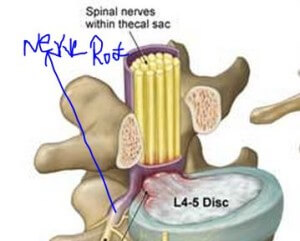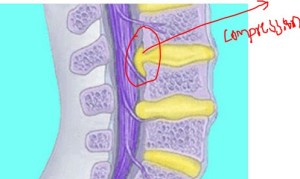Thecal Sac
What Is Thecal Sac?
Thecal sac is the layer that protects the spinal cord. It is filled with cerebrospinal Fluid and has numerous nerve roots.
Thecal sac is enclosed in the Dura Matter. Dura matter is the outer layer which covers the central nervous system, which includes the brain and spinal cord1.

Thecal sac varies in both genders. In women, the sac is wider than in men.
Purpose
Thecal sac surrounds the cerebrospinal fluid which ensures that your spine is functioning effectively.
Since thecal sac houses spinal cord and cauda equina, it cushions them against damage from other spinal structures.
Compression
Pressure exerted on the thecal sac can cause the disk to bulge. This pressure can tear the spinal cord. The severity of this pressure depends on what is causing it.
Causes
Compression of the thecal sac can arise from a number of factors. These factors include:

Brain tumors
Tumors that develop in the brain can also exert pressure on the spinal cord and nerves, which in turn impinges on thecal sac.
As a result affects the caudal nerve roots hence causing cauda equina syndrome. Cauda equina syndrome is a condition that is characterized with excessive pressure and swellings of the nerves at the end of the spinal cord.
This depends on the size of the tumors in your brain. People with very large tumors in the brain experience severe pain.
Spinal Canal Stenosis
This is the narrowing of the spinal cord. People who are above 50 years are mostly affected by spinal canal stenosis4.
Normally, your spine consists of vertebrae and discs. It cushions the spinal cord against damage.
One of the main causes of Spinal canal stenosis is arthritis, which occurs as a result of cartilage breaking down from your bone. A cartilage is a type of bone found between tissues and bones.
Osteoarthritis is a type of arthritis which affects your joints. This disease can cause the ligaments in your spine and bone to become thick. This exerts pressure on the spinal cord and nerves and compresses the disc.
Brain trauma
Injury on your brain can damage nerves and fracture the spinal cord. This can compress the thecal sac.
Cysts
Cysts can also cause compression of the thecal sac. A synovial cyst occurs when the joint in your lower spine degenerate.
This cyst is filled with fluids and is more prevalent in older people. Synovial cyst can exert pressure inside your spinal canal as well as compress the thecal sac5.
Herniated discs
Herniated disc is a small spongy disc that protects the bones which form the spine. The disc maintains the flexibility of your spine as well as cushions the spine against shocks6.
When herniated disc is damaged, it can swell and exerts pressure on your lower spine. This can compress the thecal sac.
Damage to the disc can result from injury to the spine. It can occur through wear and tear because of age; as people grow older, the disc becomes rigid.
Epidural lipomatosis
This is a disorder where fat accumulates in epidural tissue. Epidural tissue is found in the spinal space. The build-up fat causes the adipose tissue to swell until it touches the spinal cord .
This exerts pressure on the spinal cord and narrows it. The spinal cord in turn impinges on the thecal sac and other nerve structures.
Epidural lipomatosis can occur due to prolonged use of steroid therapy in some patients. It can also happen is people, who are overweight or obese.
Other medical conditions such as pituitary prolactinoma, Cushing syndrome and hypothyroidism can also cause this disorder.
Chronic adhesive arachnoiditis
This condition causes the meninges of your spine canal and nerves to be inflamed. It occurs due to any form of injury, surgery or bleeding in the spinal cord.
This disease cause fabrin to buildup and form collagen that makes the nerve roots to stick together towards the thecal sac. This exerts pressure on the thecal sac.
Symptoms
Symptoms depend on the cause of compression. The following are some of the signs and symptoms of thecal sac compression:
Most people experience pain in their lower spine. They also notice weakness in their muscles which affects their day to day activities.
When the cause is spinal stenosis, you feel severe leg weakness which affects your walking or standing upright. It can also cause loss of bowel control in some people especially when the nerves to the bowel or bladder are weakened.
Symptoms of herniated disc depend on the location of the disc on your spine. This condition may not cause any symptoms but when it is large it can cause pain and numbness in your leg and thigh. This pain can worsen when you stand up and reduce when you lay down.
Diagnosis
Diagnosis of thecal sac compression requires several tests depending on the underlying cause.
A physical examination can be done by your doctor to check for signs and symptoms. For herniated discs as the cause, your doctor will ask you about your symptoms such as pain in the leg when standing or sitting.
Blood test can also be conducted to find out if the cause in an infection.
Other tests include use of imaging techniques such as Magnetic Resonance imaging scan (MRI) and computed tomography scan (CT). X-rays can be used to determine the extent of spine degeneration. Your doctor can also use an electromyogram to find out if spinal nerves are irritated.
Treatment
In order to manage thecal sac compression, the underlying cause must be identified first. Once the cause is known, your doctor drafts a treatment plan to help treat the underlying condition and manage its symptoms.
The following treatment options can be used:
Medications
Thecal sac compression causes pain in the lower back. Your doctor will give you analgesics to help reduce lower back pain. Anti-inflammatory drugs can be used to relieve swellings and inflammation.
Surgery
Surgical intervention is the preferred choice of treatment to correct the structures near the thecal sac. Your doctor will restructure these surrounding structures before correcting the impingement in the thecal sac.
Reference List
- Thecal Sac. Available at http://medicalbite.com/thecal-sac.html
- Thecal Sac. Available at http://healthfixit.com/thecal-sac/
- Thecal Sac. Available at http://www.cure-back-pain.org/thecal-sac.html
- Spinal Stenosis. Available at http://www.webmd.com/back-pain/guide/spinal-stenosis#1
- Synovial Cyst. Available at https://www.spine-health.com/conditions/spinal-stenosis/synovial-cyst-lumbar-spine
- Herniated Disc. Available at http://www.webmd.com/back-pain/tc/herniated-disc-topic-overview#3
